Editor’s note: I realise the company is now known as Sony Interactive Entertainment, but for most of my life (and for most of Vita’s life) they were known as Sony Computer Entertainment, hence this is how I will be referring to them in this article.
The fourteenth (and final!) in a series of articles I’m writing, looking at the output of a number of Vita-supporting companies from launch through to the present day. I’ll be examining what the games they released were; (if the data is available) how well they sold; (in cases of them being ports) how well they ran; as well as a brief look at games which perhaps should have come to the console either in the west or in general.
So here’s where it all started and where it all ends (at least with this series of articles) – with Sony themselves. The manufacturer of the console are hugely divisive among the Vita fanbase as they pulled the plug on development for the console surprisingly early in its life due to weak sales, but still managed to release a variety of brilliant titles during the time they were active. Their schedule undoubtedly concentrated in the early years of its life but thanks to small initiatives such as Gio Corsi and his Third Party Productions (3PP) team, they managed to be fairly active much later than it first appears; even if their output as a whole was full of missed opportunities.
Launch & 2012 – console quality gaming on the go
The PlayStation Vita was officially announced during a “PlayStation Meeting” press conference in January of 2011. The motto of the handheld was clear – ‘console quality gaming on the go’ and to their credit that’s very much what Sony tried to deliver during the first 12 months of its life, for better or worse.
 The console launched first in Japan in December of 2011 and with it a number of Sony-developed titles showed up, many being graphical and tech showcases to demonstrate what the hardware was capable of. Leading this batch was Uncharted: Golden Abyss – the poster child of the Vita’s launch, a Sony Bend-developed spin-off of Naughty Dog’s seminal franchise was met with an interesting critical reaction. Many were impressed by what was being pulled off on the handheld, but also derided the title for not having the same level of production values as the home console versions (it was noted it wasn’t running at native resolution). It seems consumers weren’t as bothered by this as the game sold more than 110k in Japan and (according to VGChartz) more than 1.6m worldwide which is definitely a success, although well below what the series usually sells.
The console launched first in Japan in December of 2011 and with it a number of Sony-developed titles showed up, many being graphical and tech showcases to demonstrate what the hardware was capable of. Leading this batch was Uncharted: Golden Abyss – the poster child of the Vita’s launch, a Sony Bend-developed spin-off of Naughty Dog’s seminal franchise was met with an interesting critical reaction. Many were impressed by what was being pulled off on the handheld, but also derided the title for not having the same level of production values as the home console versions (it was noted it wasn’t running at native resolution). It seems consumers weren’t as bothered by this as the game sold more than 110k in Japan and (according to VGChartz) more than 1.6m worldwide which is definitely a success, although well below what the series usually sells.
The second showcase title was Everybody’s Golf (Hot Shots Golf: World Invitational in North America) which was the latest in a long line of popular casual golf sims dating back to the PS1 era. Compared to two entries on the PSP, the Vita version boasted improved graphics; new courses and plenty of extra bells and whistles – it seemed to be an essential pick-up for many gamers in Japan, where it became the best-selling title of the console’s launch (61k) and shifted nearly 250k copies by the end of 2016. Again, worldwide sales were a little below series norms according to VGChartz, clocking in at around 600k, but enough to be a relative success.
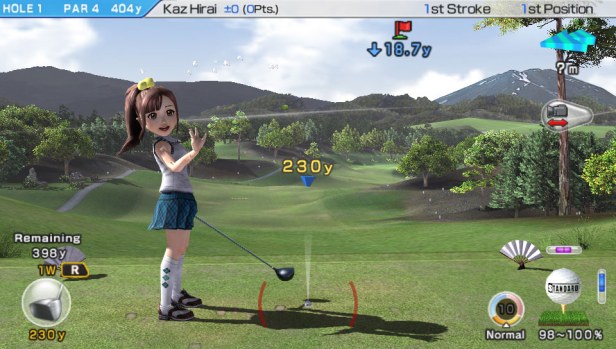 Of course, with new hardware with extra bells and whistles like Vita has, there will inevitably be developers tasked with showing off how these work. For Vita, this task fell to Motorstorm: Arctic Edge creators BigBig Studios whose mini-game collection Little Deviants used many of the console’s unique inputs including the front and rear touch screens as well as the microphone. In Japan, Monster Radar also demonstrated how the handheld’s AR functionality worked – although both games seemed to offer little more than gimmicks which was met with a muted reception from critics and consumers.
Of course, with new hardware with extra bells and whistles like Vita has, there will inevitably be developers tasked with showing off how these work. For Vita, this task fell to Motorstorm: Arctic Edge creators BigBig Studios whose mini-game collection Little Deviants used many of the console’s unique inputs including the front and rear touch screens as well as the microphone. In Japan, Monster Radar also demonstrated how the handheld’s AR functionality worked – although both games seemed to offer little more than gimmicks which was met with a muted reception from critics and consumers.
Despite the fact that the western launch was still two months away, Sony continued to provide new releases every month following Japanese release. Both Super Stardust Delta from Housemarque and WipEout 2048 from Studio Liverpool landed in Japan in January – a full month before Vita would launch in the west and both mixed gorgeous visuals with solid performance. While WipEout managed a full retail release due to the series pedigree (which was criticized for long load times), Stardust was digital-only – something that would become a common theme during Vita’s life as Sony pushed the hardware as a home for digital games.
 It was the beginning of February (and a few weeks before western launch) that Vita received its second marquee title after Uncharted. That game was Gravity Rush, an action-adventure title from the studio behind Siren: Blood Curse that featured an insomniac protagonist named Kat with the power to shift gravity, as she attempted to save her new home of Hekseville from invading aliens. If you think that sounds like a niche concept, you’d be right – while it eventually cleared 135k in Japan after a number of years, it failed to clear 600k worldwide on VGChartz figures (although it seems this wasn’t a Vita-specific problem, as a PS4-only sequel years later also failed to set the sales charts alight).
It was the beginning of February (and a few weeks before western launch) that Vita received its second marquee title after Uncharted. That game was Gravity Rush, an action-adventure title from the studio behind Siren: Blood Curse that featured an insomniac protagonist named Kat with the power to shift gravity, as she attempted to save her new home of Hekseville from invading aliens. If you think that sounds like a niche concept, you’d be right – while it eventually cleared 135k in Japan after a number of years, it failed to clear 600k worldwide on VGChartz figures (although it seems this wasn’t a Vita-specific problem, as a PS4-only sequel years later also failed to set the sales charts alight).
With Vita’s western launch in late February, a great new selection of titles were available (with third-party games, over 25 releases were available on day one). Aside from the previously mentioned titles, Modnation Racers: Road Trip was a stand-out – adapting the home console version’s racing and track-creation features into a portable format. Again, critical reception wasn’t the strongest (an unfortunate common theme among Sony’s 2012 releases on Vita) with points raised about the lack of online multiplayer and performance niggles (but again, if you’re willing to look past its flaws it’s a really good time).
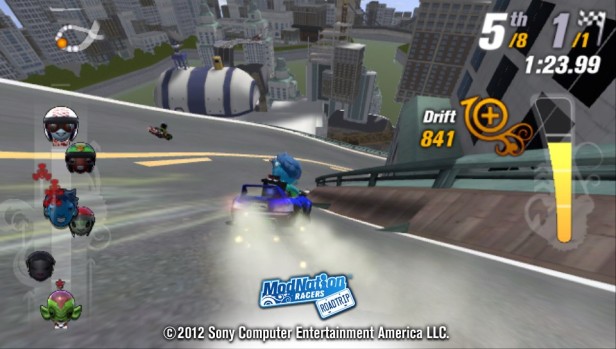 As with the Japanese launch, it was also a time that Sony experimented with titles that used the hardware’s unique inputs – games like Escape Plan showed off inventive ways of using the front and rear touch pads while Reality Fighters used the rear camera to produce AR fighters which could battle in the real world. In fact, AR would also form the basis of Cliff Diving and Table Football (both of which were there for launch); as well as the later released Table Ice Hockey and Table Top Tanks, showing Sony were going all in on this gimmick.
As with the Japanese launch, it was also a time that Sony experimented with titles that used the hardware’s unique inputs – games like Escape Plan showed off inventive ways of using the front and rear touch pads while Reality Fighters used the rear camera to produce AR fighters which could battle in the real world. In fact, AR would also form the basis of Cliff Diving and Table Football (both of which were there for launch); as well as the later released Table Ice Hockey and Table Top Tanks, showing Sony were going all in on this gimmick.
Another type of game that would form the basis of Vita’s launch would be ports of home console titles – while the majority of these came from third parties, Sony themselves still funded releases such as Hustle Kings and Top Darts (both of which were previously available on PS3). These kinds of small releases helped flesh out the handheld’s lineup as well as providing a small amount of sports representation which wasn’t already there; as well as bolstering the Vita’s digital-only portfolio.
 Sony’s final two February 2012 Vita releases would be in-keeping with this theme. The first, Motorstorm RC, was a stripped-down version of their combat-racing franchise. It had players controlling remote control cars rather than ATV’s and dirt bikes and offered cross-buy with the PS3 version, something which was a bit of a novelty but would become a key selling point for Vita in future years. Sadly this incentive wasn’t extended to Plants vs. Zombies (the popular mobile title) when that was ported to the console for launch, but it was still nice just to see the game land on Vita at all.
Sony’s final two February 2012 Vita releases would be in-keeping with this theme. The first, Motorstorm RC, was a stripped-down version of their combat-racing franchise. It had players controlling remote control cars rather than ATV’s and dirt bikes and offered cross-buy with the PS3 version, something which was a bit of a novelty but would become a key selling point for Vita in future years. Sadly this incentive wasn’t extended to Plants vs. Zombies (the popular mobile title) when that was ported to the console for launch, but it was still nice just to see the game land on Vita at all.
With so many titles available at launch, it’d be easy for Vita to lose momentum at this point, but Sony tried to keep things going. March saw the release of Unit 13, a co-operative military shooter from Zipper Interactive, the studio behind the successful SOCOM series. Featuring a more arcade-y edge than many would have expected, the game filled a gap in the console’s library by being the first true third-person shooter to use the dual-analogue controls – although this didn’t necessarily win over reviewers. March would also be home to the latest entry in the popular MLB: The Show series in ’12, which continued the PSP’s tradition of being fantastic handheld sports titles, nearly feature-complete with the home console release.
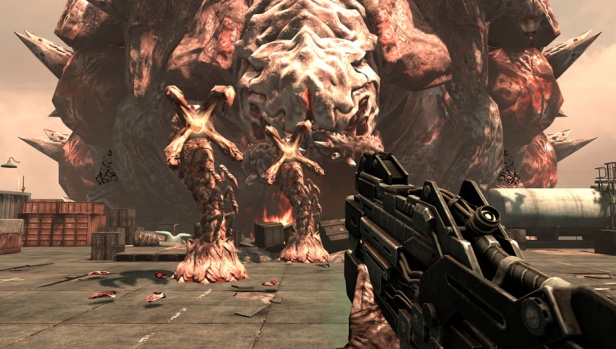 Following this however, releases definitely slowed down. April saw nothing from Sony and it would take until the May for a new game to arrive in the free-to-play app Frobisher Says!, which did little to alleviate the drought – beyond this was Resistance: Burning Skies from developer Nihilistic Software. While it became the first dual-analogue first-person shooter on a handheld ever made, this did little to win over critics who found it a rather dull experience. In spite of this, the studio would later go on to develop Call of Duty: Black Ops Declassified for Activision, which would go on to an even greater critical beating.
Following this however, releases definitely slowed down. April saw nothing from Sony and it would take until the May for a new game to arrive in the free-to-play app Frobisher Says!, which did little to alleviate the drought – beyond this was Resistance: Burning Skies from developer Nihilistic Software. While it became the first dual-analogue first-person shooter on a handheld ever made, this did little to win over critics who found it a rather dull experience. In spite of this, the studio would later go on to develop Call of Duty: Black Ops Declassified for Activision, which would go on to an even greater critical beating.
June would see the interesting AR app Pulzar arrive (as well as the western launch of Gravity Rush) but after that it was a long wait until the next release – Sound Shapes – in August. While it could be excused that gamers were still likely playing one of the multitude of launch titles, it showed a lack of forward planning from Sony to properly space out their releases to keep people entertained. Thankfully Sound Shapes‘ brilliant platforming gameplay and level editor was received well giving gamers plenty to do, even if it was arguably usurped just a month later.
 That title was LittleBigPlanet – a Vita version of Sony’s popular “play-create-share” line of platformers. Gamers and critics alike seemed to agree that the title fit perfectly on to Vita, thanks to the touch-screen and rear touch enhancing the experience in ways that couldn’t be replicated on a home console; as well as providing a fun family-friendly title for the new handheld. The game was prime bundle fodder for the holidays and it seems this was indeed reflected in sales – at more than 1.35m (once again on VGChartz figues), it sits in the upper echelon of Vita software sales.
That title was LittleBigPlanet – a Vita version of Sony’s popular “play-create-share” line of platformers. Gamers and critics alike seemed to agree that the title fit perfectly on to Vita, thanks to the touch-screen and rear touch enhancing the experience in ways that couldn’t be replicated on a home console; as well as providing a fun family-friendly title for the new handheld. The game was prime bundle fodder for the holidays and it seems this was indeed reflected in sales – at more than 1.35m (once again on VGChartz figues), it sits in the upper echelon of Vita software sales.
After this, Sony took a step back from publishing during the holidays – instead letting third-parties lead the way on Vita with titles like Assassin’s Creed III: Liberation and Call of Duty: Black Ops Declassified. Their only retail release for the holidays (aside from Smart As, a brain-training game which totally missed that craze by about a decade) was PlayStation All-Stars Battle Royale – a crossover fighter featuring characters from a variety of PlayStation franchises. When the game was revealed at E3 2012, it received some fairly negative feedback from fans ranging from criticism about missing characters to claims it was just a blatant rip off of Nintendo’s Super Smash Bros. Either way, it wasn’t exactly an ideal holiday title receiving fairly muted critical reviews and negative word-of-mouth (even if it was a game which I loved personally – it did eventually go on to shift more than a million copies).
 They capped off the year with two digital-only releases – Uncharted: Fight for Fortune was a collectable card game based on their popular action IP while When Vikings Attack! was a bonkers arena fighting game. It marked a muted end to a rather interesting year for Sony – you certainly couldn’t knock them for quantity, but quality was lacking in certain areas leading to some tentpole titles taking a critical beating. It certainly didn’t help get Vita off to the best start, but rather than attempting to fix this for future years they merely dialled back support altogether.
They capped off the year with two digital-only releases – Uncharted: Fight for Fortune was a collectable card game based on their popular action IP while When Vikings Attack! was a bonkers arena fighting game. It marked a muted end to a rather interesting year for Sony – you certainly couldn’t knock them for quantity, but quality was lacking in certain areas leading to some tentpole titles taking a critical beating. It certainly didn’t help get Vita off to the best start, but rather than attempting to fix this for future years they merely dialled back support altogether.
2013 – Sony’s best Vita titles?
For Vita’s sophomore year, Sony delivered a number of quality titles which helped strengthen the console’s library; although it was also a patchy year where it became clear that they were winding down on supporting the handheld with AAA releases.
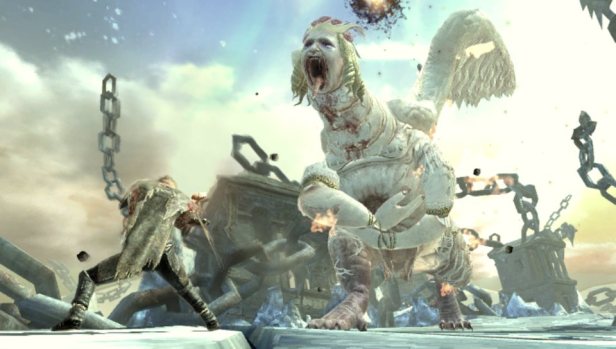 The year kicked off with the release of the delayed Sly Cooper: Thieves in Time, which was originally scheduled to launch in 2012. Development was shifted from series creators Sucker Punch Productions to Sanzaru Games, who had handled a remaster of the previous three titles on PS3. It proved to be an inspired choice as – aside from niggles with the story – the game was well-received and proved a great 3D platformer addition for Vita (it also released alongside a mini-game collection entitled Bentley’s Hackpack). Also releasing at the start of the year was MLB 13: The Show, the latest iteration of Sony San Diego’s premier sporting franchise.
The year kicked off with the release of the delayed Sly Cooper: Thieves in Time, which was originally scheduled to launch in 2012. Development was shifted from series creators Sucker Punch Productions to Sanzaru Games, who had handled a remaster of the previous three titles on PS3. It proved to be an inspired choice as – aside from niggles with the story – the game was well-received and proved a great 3D platformer addition for Vita (it also released alongside a mini-game collection entitled Bentley’s Hackpack). Also releasing at the start of the year was MLB 13: The Show, the latest iteration of Sony San Diego’s premier sporting franchise.
Japan saw the release of Soul Sacrifice in March, a new action-hunting game from Mega Man alumni Keiji Inafune. A high-budget production mixing in a dark gothic story with an interesting progression system based on karma (the player can choose to save or sacrifice the creatures they kill), the game was heavily promoted in Sony’s homeland due to its similarities to the popular Monster Hunter franchise which led to sales success of over 225k copies sold. A western release followed in May, where it became the first major Sony published exclusive since LittleBigPlanet way back in September.
 Summer saw the publisher take a different turn – there was a big focus on kid-friendly games in an attempt to find success from taking a different direction. Their tentpole release for this was the Jak & Daxter Collection, a port of three PS2-era titles that sadly suffered from terrible framerate and performance issues (although they’re still enjoyable games in my opinion). At least it received a physical release, which is more than could be said for their super-late port of 2012’s Ratchet & Clank: Q-Force (Full Frontal Assault in NA) that was another technical disappointment, but at least managed to be cross-buy with its PS3 counterpart as promised.
Summer saw the publisher take a different turn – there was a big focus on kid-friendly games in an attempt to find success from taking a different direction. Their tentpole release for this was the Jak & Daxter Collection, a port of three PS2-era titles that sadly suffered from terrible framerate and performance issues (although they’re still enjoyable games in my opinion). At least it received a physical release, which is more than could be said for their super-late port of 2012’s Ratchet & Clank: Q-Force (Full Frontal Assault in NA) that was another technical disappointment, but at least managed to be cross-buy with its PS3 counterpart as promised.
Another child-friendly project during this time was Epic Mickey 2: The Power of Two which again had released for other consoles in 2012, but rather bizarrely Sony commissioned to port over to Vita in 2013. In fact, this wasn’t the only case of Sony handling another publisher’s title as they also teamed up with Telltale Games to bring the multiple game-of-the-year winning The Walking Dead: Season One to the handheld, which aside from some performance niggles was a great time – and would briefly lead to Telltale continuing to port their games to the console and self-publish them.
 It was the holiday season which would see Sony step up their efforts in terms of output, with two key releases that would be seen as being among the best games on Vita. The first of these was Killzone Mercenary, a much-anticipated spin-off to the premier first-person shooter franchise developed by Guerrilla Cambridge, a studio known for their work on the MediEvil series. The title was undoubtedly the best-looking game on the handheld, sporting gorgeous graphics that seemed impossible on the hardware they were running on, as well as featuring an interesting twist on the series’ traditional gameplay. Reviews seemed overly nit-picky and this may have been reflected in sales, as VGChartz has the game selling 900k copies which is on the low side for the series.
It was the holiday season which would see Sony step up their efforts in terms of output, with two key releases that would be seen as being among the best games on Vita. The first of these was Killzone Mercenary, a much-anticipated spin-off to the premier first-person shooter franchise developed by Guerrilla Cambridge, a studio known for their work on the MediEvil series. The title was undoubtedly the best-looking game on the handheld, sporting gorgeous graphics that seemed impossible on the hardware they were running on, as well as featuring an interesting twist on the series’ traditional gameplay. Reviews seemed overly nit-picky and this may have been reflected in sales, as VGChartz has the game selling 900k copies which is on the low side for the series.
It was their other game for the holiday season that would attract much more critical acclaim, although even lower sales. This was Tearaway, a 3D exploration-platformer from Media Molecule (creators of LittleBigPlanet) that used all of the handheld’s unique inputs (ranging front and rear touch to microphone and gyroscope) in interesting ways. The papery adventure received an 87 average on Metacritic (and I personally loved it too) but it seems it didn’t resonate well with consumers, shifting just 14k copies in its first month on sale in the USA. As with Gravity Rush, a later PS4 port sold even worse, suggesting it was just a niche game rather than anything to do with Vita.
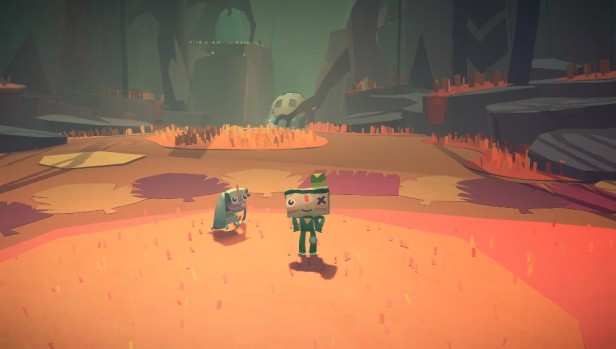 Their other retail release for the holiday season was Invizimals: The Alliance, an augmented reality collectable monster-raising game and sequel to multiple PSP titles which were hugely popular in Europe. The newest entry felt right at home on the Vita thanks to its built-in camera and touch screen, although it received a delayed release in North America for unknown reasons. Sony also published the free-to-play app Invizimals Hidden Challenges as well as other AR titles such as Open Me! and Table Mini-Golf, the former of which was a unique experience on Vita from the creators of Tokyo Jungle.
Their other retail release for the holiday season was Invizimals: The Alliance, an augmented reality collectable monster-raising game and sequel to multiple PSP titles which were hugely popular in Europe. The newest entry felt right at home on the Vita thanks to its built-in camera and touch screen, although it received a delayed release in North America for unknown reasons. Sony also published the free-to-play app Invizimals Hidden Challenges as well as other AR titles such as Open Me! and Table Mini-Golf, the former of which was a unique experience on Vita from the creators of Tokyo Jungle.
While their retail-level games were slowing down, Sony were going from strength to strength with digital-only releases. Among 2013’s highlights was Doki-Doki Universe, a memorable adventure about a exploring a robot’s humanity; as well as a port of the boss-battle action game Malicious Rebirth which made some solid improvements over the PS3 original. Both received mixed reviews but did a good job of adding variety to the handheld’s library.
 Thankfully, a couple of late PS3 ports fared much better – both of them from the renowned studio Thatgamecompany. The first of these, Flower, landed in November and was a solid port of the meditative art game; while Flow landed in December despite already being available on Vita through backwards-compatibility with the PSP port (interestingly, by the same developer – SuperVillain Studios). Both games reviewed well and although sales figures are unavailable, ports of similar games after these suggests that they did well for further investment.
Thankfully, a couple of late PS3 ports fared much better – both of them from the renowned studio Thatgamecompany. The first of these, Flower, landed in November and was a solid port of the meditative art game; while Flow landed in December despite already being available on Vita through backwards-compatibility with the PSP port (interestingly, by the same developer – SuperVillain Studios). Both games reviewed well and although sales figures are unavailable, ports of similar games after these suggests that they did well for further investment.
Another digital avenue the company were pursuing were free-to-play titles and apps. These ranged from Ecolibrium, a fun if time-consuming ecosystem-raising sim; Imaginstruments, a bizarre music creation tool and Wake-Up Club, an alarm which also acted as a mini-game collection. All of these received a mixed critical reception and it’s difficult to measure their success, although Sony did try again with F2P titles on Vita.
 In terms of missed opportunities, three things stand out from 2013. The first is Puppeteer – a bizarre platform adventure from Japan Studio that got sent out to die on PS3 despite receiving good reviews, but would likely have received a lot more attention with a handheld port added (why this didn’t happen is unknown, but Sony really should have been pushing these types of games on Vita). The second is Ratchet & Clank: Into the Nexus, the latest in the long-running series – with Q-Force receiving a port earlier in the year this seemed a shoe-in, but didn’t happen for whatever reason (despite numerous ratings boards suggesting a Vita version was on the cards).
In terms of missed opportunities, three things stand out from 2013. The first is Puppeteer – a bizarre platform adventure from Japan Studio that got sent out to die on PS3 despite receiving good reviews, but would likely have received a lot more attention with a handheld port added (why this didn’t happen is unknown, but Sony really should have been pushing these types of games on Vita). The second is Ratchet & Clank: Into the Nexus, the latest in the long-running series – with Q-Force receiving a port earlier in the year this seemed a shoe-in, but didn’t happen for whatever reason (despite numerous ratings boards suggesting a Vita version was on the cards).
However the biggest disappointment of 2013 was undoubtedly the cancellation of Warrior’s Lair (formally known as Ruin), a dungeon-crawler RPG which had been a big part of the Vita’s early life. The reasons for this cancellation are unknown – it’s especially strange given claims from an ex-developer that the project was nearly finished – but either way, a good isometric dungeon crawler would have done wonders for expanding the Vita’s library.
Overall, it was a solid year for Sony – they released a number of key titles and even more experiments, although not all of these worked out. The coming year would see even less support from them and the western branch would almost universally drop the handheld in the coming months, although a new initiative set up would provide some great support far into the future.
2014 – a downturn but some brilliant old ports
2014 would see two lots of new Vita hardware in the west – the Slim (LCD) handheld model and the PSTV home console. It was the year where the platform should have been reborn – but instead, some half-hearted Sony support very much cemented it as a niche device which would rarely attract mainstream support.
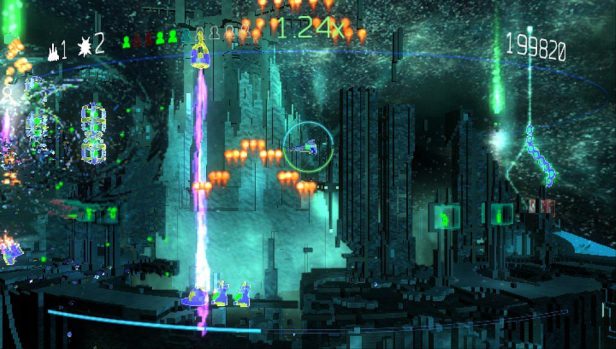 As always, the year started with the annual release of MLB: The Show – 2014’s version saw a few tweaks to the formula but nothing spectacular. It was joined in March by Destiny of Spirits, a free-to-play strategy role-playing game from Q-Entertainment that offered plenty of content for owners of the console – it was quickly downloaded over 500,000 times but it seems this success was short-lived, as the servers were shut down just over a year later.
As always, the year started with the annual release of MLB: The Show – 2014’s version saw a few tweaks to the formula but nothing spectacular. It was joined in March by Destiny of Spirits, a free-to-play strategy role-playing game from Q-Entertainment that offered plenty of content for owners of the console – it was quickly downloaded over 500,000 times but it seems this success was short-lived, as the servers were shut down just over a year later.
Another April release was Dead Nation – a twin-stick shooter from masters of the genre Housemarque. This would mark the company’s third release for Sony handhelds after Super Stardust Portable on PSP and Super Stardust Delta on Vita, but this time the port was handed to an external developer in Climax Studios. Climax would go on to handle the December release of Resogun, a PS4 launch title that was tidily adapted to Sony’s handheld.
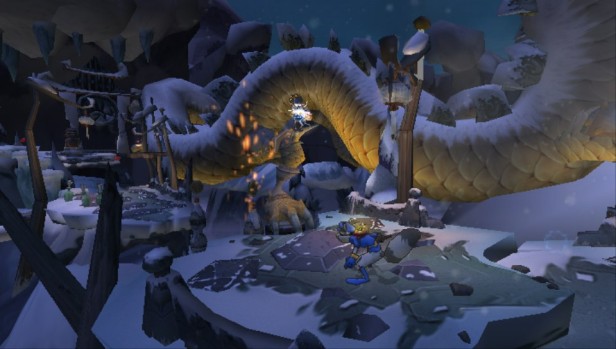 April would prove to be a busy month for Sony as they also released Sly Cooper Collection – a bundling of three PS2-era platformers starting the titular raccoon that was ported over by Sanzaru Games (who had handled 2013’s Sly Cooper: Thieves in Time). It was a great addition to the platform – the games were solid technical achievements aside from some frustratingly compressed cutscenes and the ability to be able to play the whole franchise on the go was a great novelty (although annoyingly only the first and second titles were included on the game card – the third was a download voucher).
April would prove to be a busy month for Sony as they also released Sly Cooper Collection – a bundling of three PS2-era platformers starting the titular raccoon that was ported over by Sanzaru Games (who had handled 2013’s Sly Cooper: Thieves in Time). It was a great addition to the platform – the games were solid technical achievements aside from some frustratingly compressed cutscenes and the ability to be able to play the whole franchise on the go was a great novelty (although annoyingly only the first and second titles were included on the game card – the third was a download voucher).
In fact this wasn’t the only HD port that Sony would commission for Vita during the year, as they also published the God of War Collection (the first and second titles) as well as the Ratchet & Clank Collection (a bundle of the first three games) during the summer. Both were questionable ports featuring performance issues and bugs and neither lit up the sales charts suggesting fans weren’t too bothered with these late ports (for me though, it was brilliant being able to have portable versions of these franchises I loved).
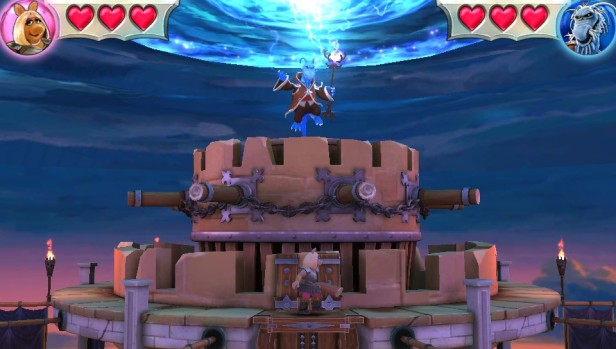 The rest of summer would see yet more child-friendly from the company, first off in the form of a bizarre creature-raising simulator featuring talking dogs. This was PlayStation Vita Pets from developer Spiral House – it was followed in November by Muppets Movie Adventures from long-time Sony collaborator Virtual Toys then in December by Invizimals: The Resistance from Novarama (a sequel to 2013’s The Alliance). All three received a bit of a critical beating, but each played a part in Sony attempting to re-position Vita as a youth-friendly handheld (as seen in adverts such as this one from Sony UK) which seemed to be met with mixed sales success.
The rest of summer would see yet more child-friendly from the company, first off in the form of a bizarre creature-raising simulator featuring talking dogs. This was PlayStation Vita Pets from developer Spiral House – it was followed in November by Muppets Movie Adventures from long-time Sony collaborator Virtual Toys then in December by Invizimals: The Resistance from Novarama (a sequel to 2013’s The Alliance). All three received a bit of a critical beating, but each played a part in Sony attempting to re-position Vita as a youth-friendly handheld (as seen in adverts such as this one from Sony UK) which seemed to be met with mixed sales success.
Undoubtedly the biggest part of their younger-audience push was in Minecraft, the multi-million selling blockbuster smash from Mojang. Prior to their acquisition by Microsoft, Sony paid to publish the game on PlayStation platforms – including Vita – where it became an instant success and regularly topped the UK retail charts, suggesting the game did very well on the platform. Its biggest success was in Japan, but I’ll cover that more in the 2015 section for reasons that will make sense when I get there.
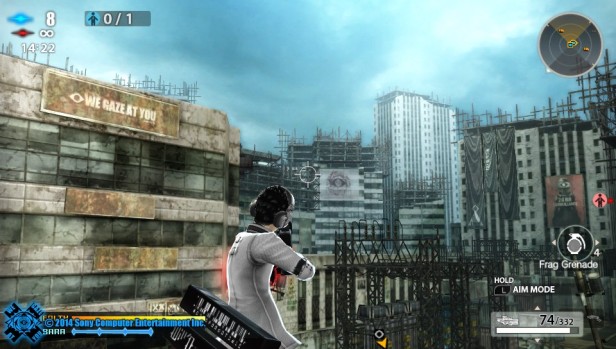 Speaking of Japan, Sony did attempt to push the Vita there which was very much appreciated. Since 2013, their big focus was hunting games (in Monster Hunter’s absence), with titles ranging from God Eater 2 to Toukiden highlighted. In June, they took another stab at the genre with Freedom Wars which it seemed to be a huge success, shifting over 188k copies in its first week and nearly 300k by the end of the year. In spite of this, it received some rough feedback from Japanese fans, but most of these issues were patched for the western release which followed in October. Sony also released an expanded version of Soul Sacrifice (their first attempt at a hunting game) in 2014 subtitled Delta which hit western shores as a digital-only game in May.
Speaking of Japan, Sony did attempt to push the Vita there which was very much appreciated. Since 2013, their big focus was hunting games (in Monster Hunter’s absence), with titles ranging from God Eater 2 to Toukiden highlighted. In June, they took another stab at the genre with Freedom Wars which it seemed to be a huge success, shifting over 188k copies in its first week and nearly 300k by the end of the year. In spite of this, it received some rough feedback from Japanese fans, but most of these issues were patched for the western release which followed in October. Sony also released an expanded version of Soul Sacrifice (their first attempt at a hunting game) in 2014 subtitled Delta which hit western shores as a digital-only game in May.
Freedom Wars‘ October release coincided with the launch of the PlayStation TV in the west and was one of the key pieces of software highlighted alongside it. This wasn’t the only hardware Sony launched in 2014 though – a remodelled Vita (LCD/Slim depending on who you ask) hit in May and the showpiece software was Borderlands 2 which was interesting for a number of reasons. For starters, it was another port of an external partner’s game – except this time it was handled by a specific initiative within the company named Third Party Productions, headed by Gio Corsi (who would go on to be pretty much the only Vita supporter left in Sony from hereon out). The port itself was riddled with bugs, slowdown and performance issues – although it was patched repeatedly post-launch, which was unexpected (sadly, the missing DLC packs were never addressed).
 To give new Vita owners something to play, Sony did release a number of pieces of digital-only software throughout the year. Titles such as Murasaki Baby made interesting use of the hardware, while multi-platform releases with PS4 & PS3 were common in games like Counterspy; Entwined; Hohokum and Pixeljunk Shooter Ultimate. They also commissioned a touch-based version of the classic puzzler Lemmings, as well as moving the formerly PS3-exclusive adventure The Unfinished Swan to both Vita and PS4 (where it shined on the handheld).
To give new Vita owners something to play, Sony did release a number of pieces of digital-only software throughout the year. Titles such as Murasaki Baby made interesting use of the hardware, while multi-platform releases with PS4 & PS3 were common in games like Counterspy; Entwined; Hohokum and Pixeljunk Shooter Ultimate. They also commissioned a touch-based version of the classic puzzler Lemmings, as well as moving the formerly PS3-exclusive adventure The Unfinished Swan to both Vita and PS4 (where it shined on the handheld).
A couple of final surprises came at the end of the year with stealth-releases of the PS1 classics Suikoden 1 & 2 (in partnership with Konami) and Vib Ribbon, but it was becoming increasingly apparent that the days of Sony investing major resources in Vita were gone. Personally, I loved Sony’s 2014 Vita output as I’m a big fan of replaying classic games on handhelds, but for many it was a disappointing year plagued by a poor port of Borderlands and little else to show and this mindset wasn’t something that would improve going into 2015.
2015 – where have you gone, Sony?
While 2014 had at least provided some solid support, 2015 was a massive downturn in output – it was basically a year where the scraps of what was left in development came out, with very little new on the cards aside from 3PP games.
 Sony started the year with the launch of the free-to-play Fat Princess: Piece of Cake, a spin-off of their popular PS3 brawler which instead mixed match-three game with minor RPG mechanics. It was something the company tried again in March with Run Sackboy! Run!, an endless runner version of their platformer IP LittleBigPlanet. Both made fun time-waster distractions but did little to diversify the Vita’s library, which was disappointing at this stage in the console’s life (and sadly Fat Princess was shut down after just a year of service).
Sony started the year with the launch of the free-to-play Fat Princess: Piece of Cake, a spin-off of their popular PS3 brawler which instead mixed match-three game with minor RPG mechanics. It was something the company tried again in March with Run Sackboy! Run!, an endless runner version of their platformer IP LittleBigPlanet. Both made fun time-waster distractions but did little to diversify the Vita’s library, which was disappointing at this stage in the console’s life (and sadly Fat Princess was shut down after just a year of service).
While Vita was getting free-to-play spinoffs, it was sadly missing the main versions of these series and Sony missed opportunities to bring relevant titles to Vita during the year. A new Fat Princess game (Adventures) arrived on PS4 during 2015 and mixed things up with action-RPG gameplay and it was preceded by the 2014 release of LittleBigPlanet 3 on PS3 & PS4. It might have been a bit of a technical challenge to get these games running on the hardware, but these are the kinds of titles that absolutely should have been targeting the handheld and would’ve made perfect sense on it.
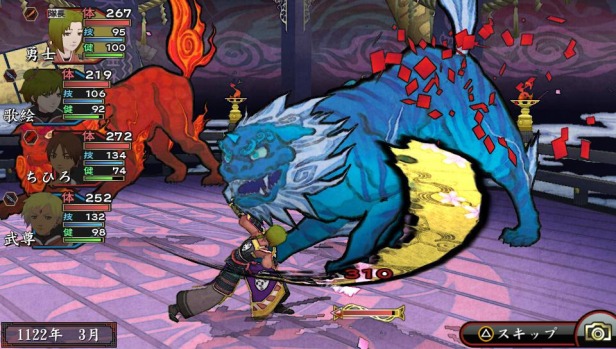 Also skipped during 2015 was a port of the critically beloved Journey from Thatgamecompany which arrived on PS4 in July. The developers commented that they would have loved to see it on Vita, but it didn’t happen for whatever reason. Similarly slipping through the cracks was Guns Up!, a free-to-play military shooter which had previously been announced for PS3 & Vita only to be unceremoniously dropped for both platforms at the final hurdle for unknown reasons.
Also skipped during 2015 was a port of the critically beloved Journey from Thatgamecompany which arrived on PS4 in July. The developers commented that they would have loved to see it on Vita, but it didn’t happen for whatever reason. Similarly slipping through the cracks was Guns Up!, a free-to-play military shooter which had previously been announced for PS3 & Vita only to be unceremoniously dropped for both platforms at the final hurdle for unknown reasons.
Still, I’m focusing on the negatives – there were some positives during 2015. Chief among these was Oreshika: Tainted Bloodlines, a deep turn-based RPG and sequel to cult classic PS1 game which hit Japan in 2014 but arrived in the west in 2015 (and although it was a digital-only release, a physical English copy was available in Asia). Also hitting during the year was the final handheld entry in the MLB: The Show series; the unique adventure Monsterbag and the surprisingly popular co-operative multiplayer shooter Helldivers.
 What was even more interesting was a regional initiative that had started and seemed completely independent of Sony as a whole. Spanish developer Virtual Toys – responsible for 2014’s Muppet Movie Adventures – developed a further two Vita titles during 2015 under Sony publishing (Looney Tunes: Galactic Sports and Phineas and Ferb: Day of Doofenschmirtz) that provided brief distractions tied to popular kid’s IP’s. It seemed like these releases would continue as IGN Spain announced that Mickey & Friends: The Haunted Mansion and Monsters University would be coming to Vita, but as of the date of this article these games never materialised suggesting they were quietly killed with the rest of Sony’s Vita development.
What was even more interesting was a regional initiative that had started and seemed completely independent of Sony as a whole. Spanish developer Virtual Toys – responsible for 2014’s Muppet Movie Adventures – developed a further two Vita titles during 2015 under Sony publishing (Looney Tunes: Galactic Sports and Phineas and Ferb: Day of Doofenschmirtz) that provided brief distractions tied to popular kid’s IP’s. It seemed like these releases would continue as IGN Spain announced that Mickey & Friends: The Haunted Mansion and Monsters University would be coming to Vita, but as of the date of this article these games never materialised suggesting they were quietly killed with the rest of Sony’s Vita development.
Something that wasn’t being killed off was the work of Third Party Productions, though. After handling Borderlands 2 in 2014, the next big project they took on was Resident Evil Revelations 2. Although this was officially published by Capcom, it seems 3PP helped organize a porting studio for the game (Frima Studio) as well as publicise it. Sadly, just like Borderlands, the port was a bit of a technical mess that clearly wasn’t optimized for the handheld – again it was later patched, but remained a less-than-ideal way to play (plus it was digital-only in the west, although at least an Asian-English physical release – just like with Oreshika – exists).
 Of course, this wasn’t all they worked on during the year – multiple other indie titles ranging from Bastion to Octodad: Dadliest Catch to Towerfall Ascension were arranged through 3PP, many relying on tried-and-trusted porting studios like Blitworks; Code Mystics and Sickhead Games to get the title shipped (you can read my thoughts on the success of these porting studios here). It’s difficult to keep track on the projects 3PP were directly involved with, but there was certainly a multitude of games that they were up-front about.
Of course, this wasn’t all they worked on during the year – multiple other indie titles ranging from Bastion to Octodad: Dadliest Catch to Towerfall Ascension were arranged through 3PP, many relying on tried-and-trusted porting studios like Blitworks; Code Mystics and Sickhead Games to get the title shipped (you can read my thoughts on the success of these porting studios here). It’s difficult to keep track on the projects 3PP were directly involved with, but there was certainly a multitude of games that they were up-front about.
A number of common partnerships for 3PP would pop up over the coming years too. One of these would be with Double Fine Productions who brought both their Kickstarted Broken Age as well as the classic LucasArts title Grim Fandango to Vita in 2015. It was so nice to see point ‘n’ click/adventure games like this landing on the handheld as they tended to work so well as portable games; plus they filled a nice gap left by the absence of Telltale Games. Another partnership that kept returning was with SNK – who worked with Code Mystics to port their classic Metal Slug 3 to the console in 2015 but would release many more Vita titles over the coming years.
 One final point to mention during 2015 is Minecraft. Released worldwide the previous year, it finally received a physical release in Japan in March – where it was the first physical version available in the region and became somewhat of a phenomenon helping to give the handheld’s hardware sales a new lease of life. Over 1.2m copies were sold in Japan alone (not even counting digital sales) – vastly outpacing the second place game God Eater 2 which sold 450k; Minecraft became the centre of two years worth of holiday advertising campaigns from Sony and truly helped to revitalise the console in the region, which likely led to more investment from third parties than it would have had otherwise.
One final point to mention during 2015 is Minecraft. Released worldwide the previous year, it finally received a physical release in Japan in March – where it was the first physical version available in the region and became somewhat of a phenomenon helping to give the handheld’s hardware sales a new lease of life. Over 1.2m copies were sold in Japan alone (not even counting digital sales) – vastly outpacing the second place game God Eater 2 which sold 450k; Minecraft became the centre of two years worth of holiday advertising campaigns from Sony and truly helped to revitalise the console in the region, which likely led to more investment from third parties than it would have had otherwise.
Yet the company themselves did nothing to act upon this. No similar software was created (admittedly they did heavily advertise Dragon Quest Builders from Square-Enix) nor were any games developed at all, let alone titles aimed at their new primary-school age userbase. Given 2015 was the last year they handled published titles in the west, too (BigFest in December being the last Sony release I can see) it marked a poor end to their output on a sadly neglected handheld (even Nintendo managed to pump out a Zelda for Wii U’s last breath); yet thanks to the efforts of the Third Party Productions team, the story wasn’t quite over yet.
2016 – a third-party year
Given the above, there shouldn’t be anything to say about 2016, right? Well, remember that Third Party Productions were still working on Vita content and although it’s difficult to work out what they’re involved in, there are a number of titles that landed during the year that they’ve openly stated they had a hand in – so I am going to briefly talk about those, even though it’s still incredibly disappointing that Sony’s own output had stopped at this point.
 As previously mentioned, 3PP formed a lot of key partnerships during their stint on Vita and they very much relied on these during 2016. They again worked with Double Fine, remastering the PC classic Day of the Tentacle for Vita; while continuing to work with SNK in bringing their classic Neo Geo titles to the handheld, including Garou: Mark of the Wolves and The Last Blade 2 (the latter of which I found to be a great revival of a classic). They also revealed a new collaboration with Square Enix Montreal to bring their mobile-oriented Go series to Vita starting with Hitman Go in February followed by Lara Croft Go in December.
As previously mentioned, 3PP formed a lot of key partnerships during their stint on Vita and they very much relied on these during 2016. They again worked with Double Fine, remastering the PC classic Day of the Tentacle for Vita; while continuing to work with SNK in bringing their classic Neo Geo titles to the handheld, including Garou: Mark of the Wolves and The Last Blade 2 (the latter of which I found to be a great revival of a classic). They also revealed a new collaboration with Square Enix Montreal to bring their mobile-oriented Go series to Vita starting with Hitman Go in February followed by Lara Croft Go in December.
There were other projects they were involved in beyond this – oddly, most of them were rogue-likes ranging from the rhythm-based Crypt of the Necrodancer to the gothic Darkest Dungeon. They also had a hand in helping bring the critically acclaimed Risk of Rain to the handheld, which made a fantastic pick-up-and play title well suited to on-the-go play.
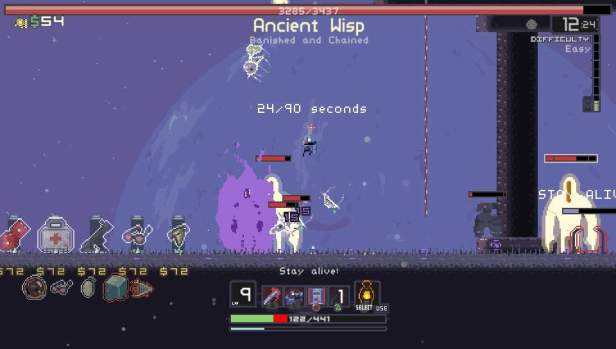 Still, this was all we got from Sony throughout the year. Elsewhere, the company were re-focusing their efforts – Vita titles like Gravity Rush were being remastered for PS4 in anticipation of the sequel landing there the following year (where it failed to set the sales charts alight – a faster-developed, cheaper Vita sequel may well have been the better choice here); while former Vita developers like Cambridge Studio seemed forced into the PlayStation VR project Rigs before ultimately being shut down – a massive shame for the devs who had created arguably one of the Vita’s defining games. In addition, a new title from Housemarque was released in Alienation – but unlike Dead Nation and Resogun, this one never managed to find its way to the handheld.
Still, this was all we got from Sony throughout the year. Elsewhere, the company were re-focusing their efforts – Vita titles like Gravity Rush were being remastered for PS4 in anticipation of the sequel landing there the following year (where it failed to set the sales charts alight – a faster-developed, cheaper Vita sequel may well have been the better choice here); while former Vita developers like Cambridge Studio seemed forced into the PlayStation VR project Rigs before ultimately being shut down – a massive shame for the devs who had created arguably one of the Vita’s defining games. In addition, a new title from Housemarque was released in Alienation – but unlike Dead Nation and Resogun, this one never managed to find its way to the handheld.
2017 & 2018 – the end of Sony, but not the end of Vita
So really, at this point there isn’t much to say – Sony pretty much abandoned Vita after 2014 save for a few leftover projects in 2015 and the remaining years of its life have been populated by a small initiative within its American branch to help indie games to bring their titles to the handheld.
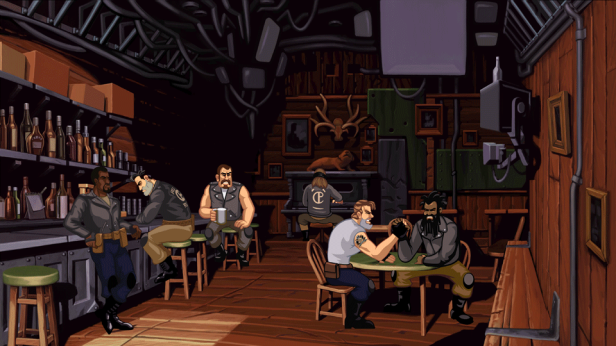 There was of course more of that in 2017 – 3PP worked with frequent collaborators Double Fine on Full Throttle Remastered and SNK on Samurai Shodown V Special, but beyond that it’s difficult to work out what they’ve been involved with. They had initially stepped in to save the Vita port of The Banner Saga, but this was subsequently cancelled (for the second time) earlier this year, a sad fate for a troubled production. With no new announcements from Gio and his team at PlayStation Experience, it suggests their run on the handheld has finally come to an end (and sadly without the release of Deus Ex Go or King of Fighters ’98).
There was of course more of that in 2017 – 3PP worked with frequent collaborators Double Fine on Full Throttle Remastered and SNK on Samurai Shodown V Special, but beyond that it’s difficult to work out what they’ve been involved with. They had initially stepped in to save the Vita port of The Banner Saga, but this was subsequently cancelled (for the second time) earlier this year, a sad fate for a troubled production. With no new announcements from Gio and his team at PlayStation Experience, it suggests their run on the handheld has finally come to an end (and sadly without the release of Deus Ex Go or King of Fighters ’98).
There was a tiny glimmer of hope earlier this year when Atsushi Morita, head of Sony Japan, reportedly re-iterated how Minecraft had kept the handheld alive in the region and also teased that the company would have a new child-friendly IP releasing during the year. As of the date of publication of this article this has failed to materialise and with nothing announced or on the horizon this either seems like a mis-translation or a load of hot air. Either way, it’s a pretty fitting way for Sony’s support of Vita to close – failing to deliver on a promise leading to disappointment.
Conclusion
This article has been by far the longest I’ve written in this series, because Sony have been involved with a larger amount of Vita software than any other publisher. Under normal circumstances, that would lead me to conclude with great praise for the publisher – but obviously for a console manufacturer it’s different and the amount of missed opportunities; un-delivered promises and just general disappointment from Sony on Vita is undeniable even in spite of some great games.
I think what’s most disappointing about the situation is that that Vita never got a second wind of development to help push it after launch – the PSP had a stonking year in 2009, four years after it first became available in the west, with great titles like Gran Turismo; Jak & Daxter: The Lost Frontier; LittleBigPlanet; Motorstorm Arctic Edge and Resistance Retribution pushing both the hardware itself and sales of the console. Comparatively, four years after Vita became available in the west was 2016 when the only part of the company still working on the handheld was Third Party Productions.
I will fully admit that Sony have been involved in some of my favourite games on the handheld – things like Killzone Mercenary; Tearaway and WipEout 2048 are fantastic examples of handheld AAA done right while having portable versions of some of my all-time favourite classics like Jak & Daxter; Ratchet & Clank and Sly Cooper is just thrilling. But their support could have been so much more – a console’s manufacturer can help make or break the success of hardware and sadly Sony were just never fully invested in Vita, leading it to be the brilliant machine it is today but one with far more potential than was ever realised.

It’s a crime that Gravity Rush isn’t more widely appreciated in general. I replayed the first one on PS4 this year immediately followed by its sequel (then wrote about both at great length — https://moegamer.net/all-games/gravity-rush/) and they’re absolutely amazing games.
LikeLiked by 1 person
Some great reading in there! I really need to go back and replay Gravity Rush. I haven’t played 2 yet because I want to revisit the original then move straight onto it!
LikeLike
A great and complete post, thank you! I got my Vita (even if I’m not a big handheld consoles fan) because the big Sony titles they were released during first year. I remember buying it in Summer 2012 thanks to a great sale, with Gravity Rush and Uncharted: Golden Abyss, followed a bit later by Everybody’s Golf / Hot Shots Golf. From that moment, a lot of great gaming moments, with big (Killzone, Tearaway) and little titles plus many PSP games I didn’t have the chance to play before. I know it hasn’t been a great success, but it has been a console I really liked.
LikeLiked by 1 person
That’s a really nice story to hear! I must admit the PSP games being playable on Vita really has been a bonus of the console for me, it’s been great! I’m glad you really like the console as much as I do!
LikeLiked by 1 person
Final? But how about article about EastAsiaSoft, hmmm… 😀
Anyway, thanks much, awesome series of documentary here.
LikeLiked by 1 person
Thanks! Yes, there’s definitely a few more publishers I could cover, but I have to have a cutoff somewhere 😀
LikeLike
I specifically meant their 100 or something physical editions of indie games, anyway 😀
LikeLiked by 1 person